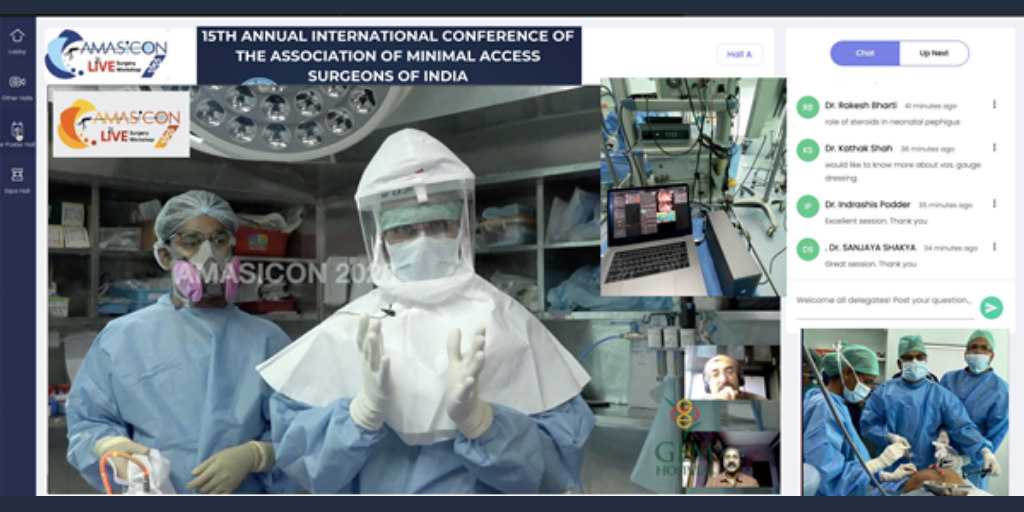AWS Public Sector Blog
Mediknit delivers high-def global surgery workshop with AWS Media Services
Mediknit is an online academy marketplace for healthcare professionals to access on-demand, need-based upskilling programs and professional development programs created by verified educators across the globe. In collaboration with GEM Institute of Laparoscopy and Robotic Surgery, Mediknit provides live surgery streams via the GEM Televersity portal for the continuing medical education (CME) needs of surgeons. With Amazon Web Services (AWS), Mediknit scaled to meet the demand to provide this streaming solution across the globe.
In November 2020, Mediknit extended this live surgical training experience to participants of an international surgery conference and workshop, which had more than 10,000 participants from over 39 countries. The conference brought together over 200 national and international surgical faculty, highlighted more than 200 paper presentations, and streamed more than 50 live surgeries from operating rooms distributed over nine countries. This was one of the world’s largest live surgery workshop, livestreamed to three virtual halls from three different national/international locations simultaneously. Plus, the content needed to be delivered from one of the most sterile, life-critical environments: the surgical operating room. We needed a failsafe, scalable, multi-source, multi-target streaming platform that could deliver content live around the world.

Dr C Palanivelu, Chairman, Gem Hospital & Research Center, addressing the audience during the virtual conference
The Mediknit platform was able to scale to meet demand, maintaining streaming quality, using AWS services including AWS Elemental Link, AWS Elemental MediaLive, and AWS Elemental MediaPackage.
How we built Mediknit
The entire streaming solution was built using AWS Media Services. During technical evaluation and solutioning phase, AWS helped with workflow architecture review and design, best practices adoption (like redundancy), and using quality-defined variable bitrate (QVBR) for multi-bitrate HLS delivery. We observed that QVBR improved the video quality and reduced the bandwidth consumption. This saved us storage and network delivery cost, in addition to creating a better user experience.
The video processing includes encoding the source video received from four remote locations in full HD (1080p) resolution. AWS Elemental MediaLive provides broadcast grade, adaptive bit rate (ABR) transcoding using QVBR control.
AWS Elemental MediaPackage reliably prepares and protects video content for delivery. MediaPackage provides just-in-time packaging and origination. Additionally, to harvest HTTP Live Streaming(HLS) output to an Amazon Simple Storage Service (Amazon S3) bucket, we setup video on demand (VOD) and archiving capabilities using AWS Elemental MediaConvert and supported content delivery using Amazon CloudFront. This helped us deliver to 10,000 viewers over three days in three virtual halls.
Using IP video, Mediknit received custom WebRTC surgery stream input from four locations in India and five international locations, which was then encoded to RTMP and was served to MediaLive.
AWS Elemental Link helped us deliver this content from the limited sterile space of an operating room. The single compact unit was simple to set up, accepted a variety of inputs, and supported high quality streaming in full HD (1080p, 60 fps). Source content fed to AWS Elemental Link was automatically streamed to AWS Elemental MediaLive in the AWS Cloud. The livestreaming parameters were remotely controlled using AWS Elemental MediaLive and AWS Elemental MediaPackage.
The source stream is pushed through AWS Elemental Link to AWS Elemental MediaLive. MediaLive transcodes the livestream in multi-bitrate HLS output to AWS Elemental MediaPackage. MediaPackage is scalable origin which offers just-in-packaging and content harvest features.
For archive and VOD, we wanted to have an mp4 archive for all of our livestreamed content, which was recorded for later viewing. We used AWS Elemental MediaPackage to create live to VoD assets (L2V). This output was stored in an Amazon S3 bucket as HTTP livestreaming format. Later we converted this HLS VOD to mp4 format using AWS Elemental MediaConvert.
Using the QVBR rate control in MediaLive rather than constant bitrate, helped optimize the bandwidth (to 25%). Also, the live to video on demand (VOD) functionality of MediaPackage was extremely useful in allowing viewers to watch the recordings instantly.
The live stream was delivered to more than 10,000 viewers in full high-definition (HD), Adaptive Bit Rate (ABR). Amazon CloudFront helped deliver this content at scale in a secure manner, providing low latency and a smooth user experience. CloudFront setup was done in the AWS Elemental MediaPackage console itself.
Ultimately, we accomplished an end-to-end solution providing a great user experience. In a post-conference feedback survey collected from over 10,000 global viewers a rating of 4.8/5 was recorded for livestreaming quality and the virtual conference experience.
To learn more about our services visit www.mediknit.org.
Learn more about AWS Media Services and AWS in India public sector.
